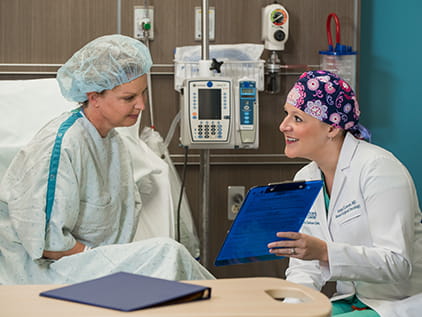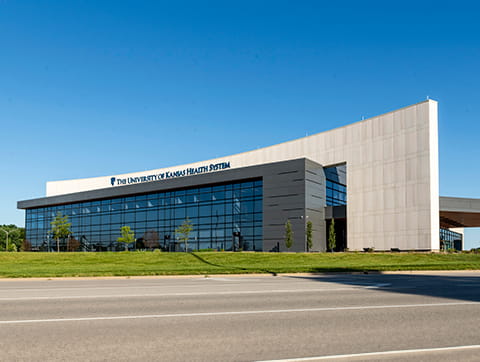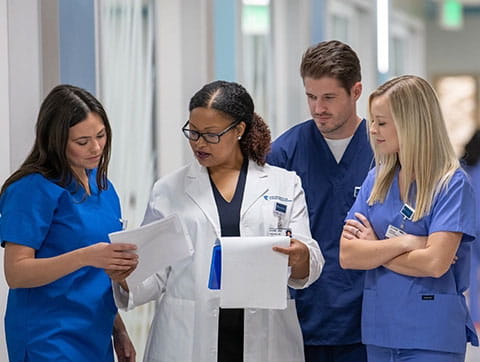- Home
- Conditions and Care
- Treatments
- Reconstructive Surgery
- Breast Reconstruction
- Tissue-Based Flap Breast Reconstruction
Breast Reconstruction
Tissue-Based Flap Breast Reconstruction
The University of Kansas Health System offers tissue-based, or “flap,” breast reconstruction for women in Kansas City who want to create their new breasts using their own tissue. This approach uses skin, muscle and fat from the body to sculpt and shape new breasts that look and feel very natural.
There are several types of tissue-based breast reconstruction. Choosing the best option for your needs requires a thorough evaluation from our specialists.
What is tissue-based breast reconstruction?
Tissue-based breast reconstruction uses your own natural tissue to reconstruct 1 or both breasts. An alternative to implant-based breast reconstruction, flap breast reconstruction is a complex surgery that can offer an excellent final result.
We offer a variety of appointment types. Learn more or call 913-588-1227 to schedule now.
Who can have flap breast reconstruction?
Women who have lost 1 or both breasts to breast cancer or other trauma may benefit from breast reconstruction. Those who are good candidates for tissue-based reconstruction:
- Do not want, or are not candidates for, implant reconstruction
- Have had failed implant reconstruction
- Have sufficient donor site tissue to create 1 or both breasts
- Are emotionally prepared and have realistic expectations
How does tissue-based breast reconstruction work?
Tissue-based reconstruction can be performed in 2 ways.
During free-flap reconstruction, the donor tissue flap is completely detached from its blood supply and microsurgically reattached to new blood vessels in the chest area. This results in better blood flow and a lower risk of fat necrosis (tissue death). Depending on the type of surgery, less muscle may also be used during a free-flap procedure, which helps speed recovery.
When the donor flap is transferred with its existing blood supply, this is called the pedicle-flap approach. This technique is common in people whose donor site is not sufficient in size, or the distance between the donor sites is too great.
Your surgeon will help you determine which approach is best for you. You will also decide where tissue will be taken from your body to create your new breasts. Your options include the back, buttocks, stomach or thighs.
- Deep inferior epigastric perforator (DIEP): This procedure removes skin and fat (no muscle) from the abdomen to create a new breast mound. Leaving the muscle unharmed allows you to maintain core strength.
- Transverse rectus abdominis muscle (TRAM) flap: The TRAM flap procedure is like the DIEP procedure except it includes removing a small part of the abdominal muscle. This can be done using a pedicle- or free-flap approach.
- Superficial inferior epigastric artery (SIEA) flap: Like the DIEP procedure, the SIEA flap approach uses only skin and fat from the lower abdomen. However, the blood vessels used during SIEA do not require an incision through the abdominal muscles, which allows for better comfort after surgery.
- Latissimus dorsi flap: This method moves skin, fat and muscle from your upper back to your chest. This technique can be used with or without breast implants.
- Superior gluteal artery perforator flap: This involves the transfer of skin and fat (no muscle) from the top of the buttocks to the breast. This procedure is often beneficial for people who don’t have enough skin or tissue in the abdomen.
- Transverse upper gracilis (TUG) flap: Skin, fat and muscle from the inner, upper thigh are transferred to create the new breast. The TUG flap can be used for people who do not have sufficient tissue in the abdominal or buttock area.
- Profunda artery perforator (PAP) flap: This procedure uses fat and skin from the upper thigh underneath the buttock crease for breast reconstruction. Using this area helps minimize the appearance of scars, as incisions are hidden in the buttock crease.

Cancer care you can count on
The University of Kansas Cancer Center is 1 of fewer than 60 NCI-designated comprehensive cancer centers in the nation, and it's part of The University of Kansas Health System.
Benefits and risks of tissue-based breast reconstruction
Breast reconstruction using your own tissue has advantages and drawbacks. Compared to implant-based breast reconstruction, tissue-based breast reconstruction:
- Is a more complex and invasive procedure
- Requires a longer recovery time and hospital stay
- Is costlier than breast implants
However, the results of tissue-based reconstruction often look and feel more natural. Plus, because you are not putting a synthetic object in your body, you avoid the risk of implant-related complications like capsular contracture. Tissue-based breast reconstruction also has a lower risk of complications for people who need radiation therapy.
Speaker 1
Wendy Murphy didn’t think she’d be around to see her daughters graduate or walk down the aisle because she was told her cancer was too advanced. Learning that diagnosis was wrong was one of the best days of her life.
Wendy Murphy
There is a rumor that if you have pain, it’s not breast cancer. And that’s a lie. I can say that for sure.
Speaker 1
Wendy Murphy blamed pain she was having in 2016 on scar tissue from breast implants. But during a trip out of town to watch her daughter play softball, the pain was so severe she made an appointment to get it checked out. Soon after, Wendy was diagnosed with breast cancer and her prognosis wasn’t good.
Wendy Murphy
He told me it was the worst kind of breast cancer you can get ̶ one you can’t recover from.
Speaker 1
Wendy decided to seek a second opinion, and friends directed her to The University of Kansas Cancer Center. That’s when Wendy learned her cancer diagnosis was wrong. The type of cancer she had was very treatable, and in just a few days Wendy started chemotherapy.
Wendy Murphy
I knew the minute I met my team that I was going to be OK. Every person I interacted with made me feel great every time. There was just a sense of knowing I was in the right place.
Speaker 1
Wendy had a big birthday during treatment. She turned 50. Another milestone followed at Belton High, where she worked, when the school honored her as the Pink Out celebrity at a football game.
Wendy Murphy
I bald headed went in front of everyone . There is a picture, and it's a very powerful picture, from the coin toss that is special.
Speaker 1
It was a big moment for Wendy, who has always been extremely self-conscious. This was part of the reason she decided early on in her cancer treatment to plan for reconstructive surgery.
Wendy Murphy
This is an emotional part for me. I struggled my whole life with body image. It was important that I have something.
Speaker 1
Plastic surgeon Dr. Julie Holding was determined to give Wendy what she wanted, a natural breast using tissue from her own body. But there were challenges. Dr. Holding patiently guided Wendy through each step, which involved 10 outpatient surgeries over 5 years, as Wendy’s breasts improved with each surgery. Wendy says her perspective and priorities did, too.
Wendy Murphy
The second important thing was that I was healthy and I took care of myself. The physical beauty part just happens to be a plus. What was most important to me was to be on this earth for my kids.
What happens during tissue-based breast reconstruction?
Breast reconstruction using autologous tissue is a major surgery that will be conducted in a hospital setting using general anesthesia. You may be encouraged to perform certain exercises to strengthen muscle and to improve blood supply in the donor area in the weeks leading up to surgery.
The specific surgical steps will vary depending on the location of the donor site tissue. Generally speaking, skin and fat are used to reconstruct the new breast. The donor tissue may be tunneled to the chest, or completely removed and replanted, depending on the technique your surgeon uses.
You can expect to recover in the hospital for the first few days after surgery so your care team can track your progress. The drains inserted during surgery to help prevent fluid buildup are removed after approximately 1 week. Prior to surgery you should arrange for someone to help you for the first weeks after your return home from the hospital. Recovery can last 4-6 weeks, depending on your health prior to surgery and the extent of the procedure.

Still the best
Our hospital continues to rank as the best in Kansas City and in Kansas according to U.S. News & World Report.

Magnet-recognized
The University of Kansas Hospital has been designated a Magnet® facility by the American Nurses Credentialing Center since 2006. 
Respect for all people
Named a leader in LGBTQ+ Healthcare Equality by the Human Rights Campaign. 



